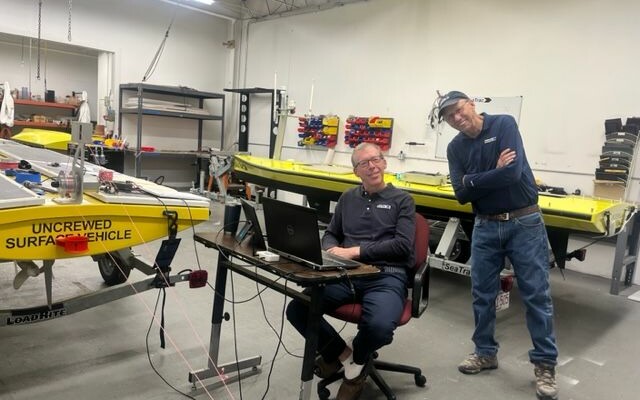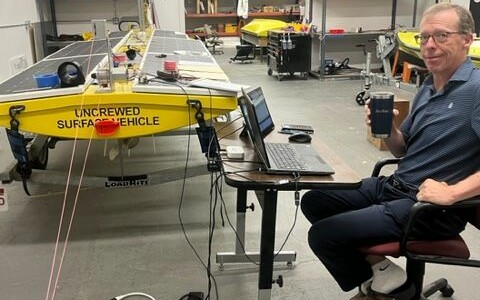Jigger Herman and Buddy Duncan, two friends and past students at the Massachusetts of Technology, got together years ago to create a sailboat and work with the guys in the America’s Cup team.
From there, they sold cutting machines they created to help sailmakers deal with the shapes and curves that needed cutting. Then they got into “smart homes” security systems because of all the traveling they were doing at that time. Now, they are the proud co-founders of SeaTrac, an uncrewed surface vessel (USV) manufacturer.
I recently visited them in their original space, where it all started long ago in Marblehead, Mass. Today they are Jigger and Buddy are working there again with colleagues Hobie Boeschenstein, SeaTrac’s director of product and business development, and communications director Alessandra Bianchi. The cubicles are still somewhat empty. Their hope is to grow and fill them once again.
How did you go from building a sailboat at MIT to cutting machines, then smart homes and now USVs?
Jigger Herman: The latest adventure is a funny story. Both Buddy and I have degrees, and a background in naval architecture. We wanted to get back to doing something on the water. Buddy was surfing the web one night and came across Liquid Robotics’ Wave Gliders. He thought it was an interesting concept and figured he could build something better and cheaper. That was seven years ago.
What makes you different from your competitors?
Jigger: In our world, boats are meant to go both offshore and near shore. Plus, manageable by a small team. Not ridiculously expensive.
Hobie: We can pivot quickly and respond to our customer needs. This includes diving into each individual use case and solving their problems. We can go to our computers, add some lines of code for their new features without the delays in waiting for approval.
Our focus here is getting the process right. That has taken a long time to get to where we are. We feel we’re in a place where we can now turn the knob quickly and get the same boat out and every time it’s going to be reliable.
Alessandra: Persistence is one of our differentiators from some of the other platforms. There are USVs that can go faster, but maybe their duration is eight hours, then they have to come back in. Ours has solar power which makes it easier and less complex to design, build, and maintain. Gas motors introduce a lot more problems.
One of the challenges we’ve tried to address with this is being able to operate it and smooth out the power curve. Solar power provides a different operating model. It gets stored and then deployed when there isn’t any sun. We like to think there’s different tools for different missions. We’ve tried to find one that provides a really flexible solution for a lot of different customer missions.

What are some of the concerns the USV solves for your customers?
Alessandra: The repeatability of the data collection. Let’s say you send a person out in a boat that is bobbing up and down due to the ocean waves and you’re putting an instrument overboard for eelgrass quality. Then three weeks later you want to do it again to compare the change. Scientists who use our boat said the exact repeatability of the data blew them away. They can recreate just what they did and precisely know location, time, etc.
Hobie: At a high level, we see it more as a collaborative effort. Traditional ways of doing things require putting people out at sea in big boats that burn lots of carbon fuel. It’s inherently expensive, dangerous, and bad for the environment.
Our is solar-powered and people don’t have to go on it. They can work from the comfort of their office and preserve a lot of quality of life for their crew. This cuts down on the attrition and turnover from people going out to sea. SeaTrac also puts their workers in a position to operate the boat more efficiently but still get the data they need to make decisions and drive their business. It’s greener, cleaner, and more cost effective.
What are some of the trials and tribulations when working with uncrewed surface vessels?
Hobie: Working on the ocean is quite challenging. Saltwater corrodes and things break. For example, a screw could come loose, or a plug doesn’t sit properly. If that happens, there isn’t anyone on the boat to fix it.
We’ve had a lot of lessons from fasteners, going through the boats, sealing things, and the propeller catching things on it. That took a lot of redesigns to get something that works.
We have a process to make sure it works every time. And I’m sure we’ll continue to learn things as we keep deploying boats.
When launching a boat, testing is key and having a process plan. There is a regimented checklist of things to go through every time a boat goes on the water to make sure it runs effectively.
How are you preventing or making sure your vessels don’t sink out there?
Hobie: We have enough backup flotation bags built into the platform that it will continue to float. And our locator beacon transmits its location back to the home port. The floatation itself could fill itself with water and it’s still going to float.
What is one tip to someone looking to get involved in these USVs?
Hobie: Testing is paramount and critical. The ocean is an expensive, unpredictable place and you’re going to learn by putting things on the water. The best way we found to build confidence in the USVs is to get out there and do it. You’re going to learn every time you go on the water and you’re going to improve based on that.




